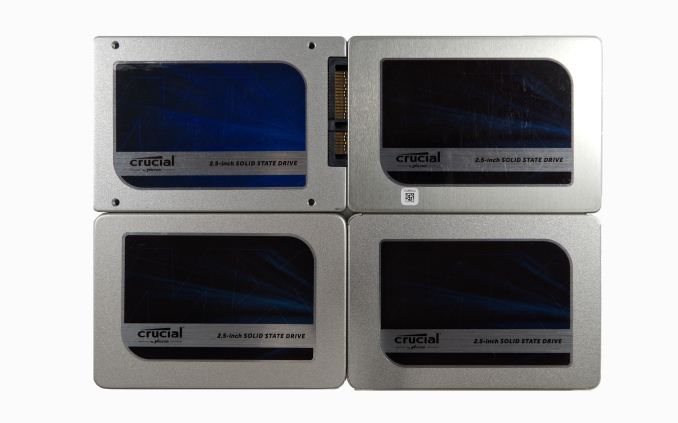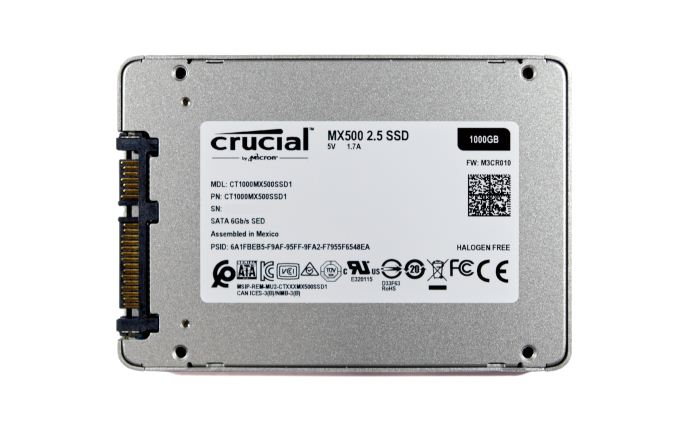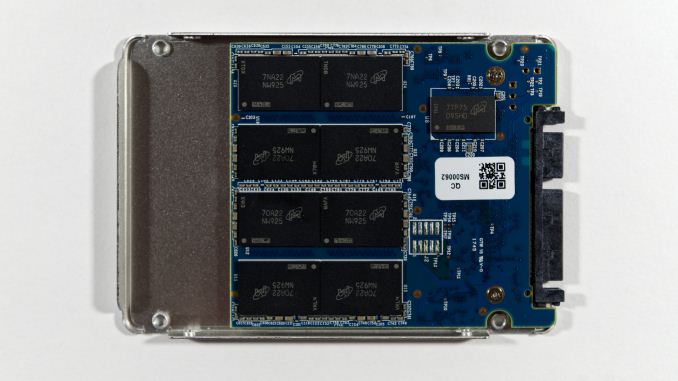
Original Link: https://www.anandtech.com/show/12165/the-crucial-mx500-1tb-ssd-review
The Crucial MX500 1TB SSD Review: Breaking The SATA Mold
by Billy Tallis on December 19, 2017 8:00 AM EST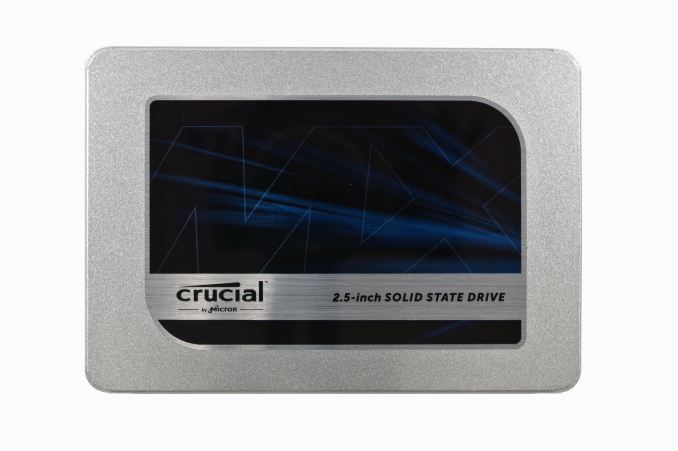
The Crucial MX500 is the next generation SATA SSD from Micron's consumer division. As the latest MX series drive, the MX500 is positioned to be a mainstream product with solid performance but without much of a premium over entry-level SSDs. Since Micron has not yet released a consumer NVMe SSD, the Crucial MX500 will also serve as their flagship consumer drive and the showcase for their new 64-layer 3D NAND flash memory.
Micron is one of several NAND flash manufacturers to introduce 64L 3D NAND this year. They're a bit late to the party considering that their NAND manufacturing partner Intel introduced started shipping their 64L 3D TLC in a retail drive six months ago, but Micron hasn't missed their chance. All of the major NAND flash manufacturers except SK Hynix are still in the early phases of rolling out their 64L 3D NAND. In a major change from the state of the industry for the past several years, there's no clear leader: Intel and Micron, Toshiba and Western Digital/SanDisk, and Samsung are all putting out products with competitive performance and pricing. The market is up for grabs, and the SATA segment that still makes up the bulk of consumer SSD sales is where the competition is fiercest.
To prepare for this next round of competition, the Crucial MX500 brings major hardware changes to what has been a slowly evolving product line stretching back to the first 6Gbps SATA SSD.
Crucial's SSD Family
Micron has struggled a bit in recent years to come up with a clear strategy for their retail Crucial-branded SSDs. Their MX series originally hit the market with the MX100 budget drive that had high enough performance to have very broad appeal. The MX200 tried to move upmarket with increased performance, and the BX series was introduced beneath it as the entry-level alternative. Micron was unable to match the performance of the top SATA SSDs with their Crucial MX200, leaving it very close to the BX100 in price and performance, and their BX200 was a serious disappointment. As the high end of the SSD market has shifted from SATA to NVMe drives, it has become harder to make a case for maintaining two tiers of consumer SATA SSD products.
The MX300 has been a solid choice for many use cases and budgets, but it hasn't been able to effectively serve the entire range of the SATA SSD market. Earlier this year, Micron introduced the Crucial BX300 as more of a niche product, specializing in performance at smaller capacities through the use of 3D MLC at surprisingly low prices. Today, Micron is skipping over the MX400 name entirely and introducing the MX500 with major changes under the hood that may allow it to be a solid replacement for both the MX300 and BX300 as they are phased out.
The 32L Intel/Micron 3D TLC used in drives like the Crucial MX300 was cheap and low-power, but didn't perform as well as Samsung's 3D NAND so it largely displaced planar TLC products and left Samsung's 850 EVO and 850 PRO almost unchallenged for performance. Our testing of the Intel 545s revealed that their second generation 3D NAND had improved on many fronts, but one model doesn't move the market all that much. The arrival of Micron's 64L NAND in the MX500 means many other companies will soon be using that NAND in their own drives.
Micron's launch strategy for the MX500 is similar to their launch of the MX300. We get one capacity today (1TB) and the rest of the lineup will be unveiled soon. The MX300 will be phased out relatively quickly as the MX500 lineup makes its way through the supply chain, but the BX300 will stick around a bit longer. Specific discontinuation dates haven't been provided, but I expect the BX300 to remain in production for several more months at least. Micron hasn't disclosed any plans for a BX400 or BX500 and instead they will probably let the BX line drop again until another niche opportunity comes along like the MX300's weakness at lower capacities.
Goodbye, Marvell
The NAND flash isn't the only significant hardware change the MX500 brings. Micron has broken the trend of using Marvell SSD controllers in the MX series and instead chosen the Silicon Motion SM2258. Silicon Motion controllers have been used in all of the BX series drives and even beyond Micron's products, SMI controllers tend to be more popular for budget products while Marvell's controllers are usually found in more expensive and higher-performing SSDs. Silicon Motion has been working to improve their controllers and move toward the high end, but the MX500 isn't even adopting the newer SM2259 controller Intel uses in the 545s. Micron says that the improvements in the SM2259 are more relevant for enterprise SSDs and that the SM2258 is good enough, when paired with their new 3D NAND.
In spite of the completely different controller, the MX500 offers all the standard features of the MX series. TCG Opal encryption is included (making this the first SMI drive we've tested with full self-encrypting drive capability). Micron's partial power loss protection feature for data at rest is preserved, but implemented in a different fashion; they're now also branding it as "power loss immunity". The impact is still the same: you don't get the full protection that is standard for enterprise SSDs, but data that has already been written to the flash will not be corrupted if the drive loses power while writing a second pass of more data to the same cells. This is a feature that can only exist for drives storing more than one bit per memory cell (ie. MLC or TLC, but not SLC), and not using a one-shot programming sequence like is possible with Toshiba/SanDisk 3D NAND.
Previous MX series drives have included banks of capacitors to provide power for a short while after an unexpected loss of external power supply. Micron's 64L 3D TLC substantially reduces the need for extra capacitors by offering a much more efficient NAND programing sequence, and by providing significant capacitance within the NAND package itself. The MX500 still includes more capacitors on its PCB than most consumer drives, but they're not as large or numerous as on previous MX series drives. This reduction in BOM suggests that we may see other users of Micron flash implement an equivalent feature in their own products.
As with the MX300 and some MX200 models, the MX500 includes SLC write caching to accelerate bursty workloads.
| Crucial MX Series Specifications | ||||
| Capacity | MX500 1TB | MX300 1050GB | MX200 1TB | |
| Form Factors | 2.5", M.2 2280 double-sided | 2.5" | 2.5" | |
| Controller | Silicon Motion SM2258 | Marvell 88SS1074 | Marvell 88SS9189 | |
| NAND | Micron 256Gb 64-layer 3D TLC | Micron 384Gb 32-layer 3D TLC |
Micron 128Gb 16nm MLC | |
| Sequential Read | 560 MB/s | 530 MB/s | 555 MB/s | |
| Sequential Write | 510 MB/s | 510 MB/s | 500 MB/s | |
| 4KB Random Read | 95k IOPS | 92k IOPS | 100k IOPS | |
| 4KB Random Write | 90k IOPS | 83k IOPS | 87k IOPS | |
| Dynamic Write Acceleration | Yes | Yes | No | |
| DevSleep Power | 4 mW | 4 mW | 2 mW | |
| Slumber Power | 65 mW | 75 mW | 100 mW | |
| Max Power | 5.0 W | 5.2 W | 5.2 W | |
| Encryption | TCG Opal 2.0 & IEEE-1667 (eDrive) | |||
| Endurance | 360 TB (~0.2 DWPD) | 220 TB (~0.2 DWPD) | 320 TB (~0.3 DWPD) | |
| Warranty | Five years | Three years | ||
| MSRP at launch | $259.99 | $249.99 | $470 | |
The performance specifications for the 1TB MX500 don't reveal any particularly interesting changes; most SATA SSDs claim something around these numbers based on unrealistic assumptions about queue depths and I/O sizes. The specs for power consumption have been reduced slightly. The MX300 was very power efficient, but it wasn't reflected that well in its basic specifications. Endurance has increased substantially to 360 TB, above even what the MLC-based 1TB MX200 offered. The warranty period has also been extended to five years, so the drive writes per day rating is not actually any better.
The introductory price of $259.99 is a bit higher than what the MX300 debuted with, but is pretty good considering how much flash prices have increased overall since then.
Micron's spec sheet indicates there will be a M.2 2280 version of the 1TB MX500, but it will be a double-sided drive. Most manufacturers try to make their 1TB models single-sided these days so they can fit into all the same notebooks that the smaller capacities work with, and Samsung has even managed to make their 2TB 960 PRO a single-sided drive.
The 1TB MX500's PCB seems a bit larger than necessary, with 16 NAND flash packages each containing two of Micron's 256Gb 64L 3D TLC dies. With just a four-channel controller, the only reason to split the NAND across so many packages is to save on packaging costs that come from stacking the NAND higher within a package. The partial power loss protection capacitors can be seen encircling the NAND package clusters, rather than being arrayed elsewhere on the PCB.
The switch to 64L 3D NAND means Micron is back to a nominal flash die capacity that is a power of two, so the unusual capacities and overprovisioning ratios of the MX300 are gone. The MX500 1TB has the standard capacity for a 1000GB drive, and the flash can be evenly balanced across the controller's four channels.
The Competition
The competition for the Crucial MX500 will consist primarily of other SATA SSDs using 3D NAND. Now that Toshiba/SanDisk 3D NAND is also shipping, we expect most brands still using planar NAND to soon discontinue those products in favor of successors using either Micron or Toshiba NAND.
Samsung's 850 PRO and 850 EVO are still among the top SATA SSDs and the 850 EVO has at times offered great performance for its price, but they're no longer alone at the top. The Intel 545s uses Intel's version of the 64L 3D TLC in the MX500, along with the Silicon Motion SM2259 controller. The Western Digital WD Blue 3D NAND and its alter-ego SanDisk Ultra 3D use SanDisk's 64L BiCS3 3D TLC NAND along with a Marvell controller, and also threaten Samsung's dominance in the SATA SSD market.
Toshiba's retail SATA SSD with 64L 3D TLC is the TR200, which uses a rebranded Phison S11 DRAMless controller, making it more of an entry-level product with limited performance potential.
Amidst various hardware swaps to support other SSD testing projects and the integration of our new Quarch XLC Programmable Power Module, something got screwed up with our primary SSD testbed that is causing The Destroyer to proceed at less than half the usual pace. Since the test normally takes at least 12 hours for a SATA SSD to complete, this isn't something easily debugged over the course of just a day or two. This issue is affecting the MX500 and the few other drives I've had time to attempt running The Destroyer on recently, so this review will be missing results from that test until I can get the testbed re-imaged and collect and validate new performance results. The other tests in our suite seem to be unaffected, and the MX500 results that appear to be outliers have already been double-checked.
| AnandTech 2017 SSD Testbed | |
| CPU | Intel Xeon E3 1240 v5 |
| Motherboard | ASRock Fatal1ty E3V5 Performance Gaming/OC |
| Chipset | Intel C232 |
| Memory | 4x 8GB G.SKILL Ripjaws DDR4-2400 CL15 |
| Graphics | AMD Radeon HD 5450, 1920x1200@60Hz |
| Software | Windows 10 x64, version 1703 |
| Linux kernel version 4.12, fio version 2.21 | |
- Thanks to Intel for the Xeon E3 1240 v5 CPU
- Thanks to ASRock for the E3V5 Performance Gaming/OC
- Thanks to G.SKILL for the Ripjaws DDR4-2400 RAM
- Thanks to Corsair for the RM750 power supply, Carbide 200R case, and Hydro H60 CPU cooler
- Thanks to Quarch for the XLC Programmable Power Module and accessories
AnandTech Storage Bench - Heavy
Our Heavy storage benchmark is proportionally more write-heavy than The Destroyer, but much shorter overall. The total writes in the Heavy test aren't enough to fill the drive, so performance never drops down to steady state. This test is far more representative of a power user's day to day usage, and is heavily influenced by the drive's peak performance. The Heavy workload test details can be found here. This test is run twice, once on a freshly erased drive and once after filling the drive with sequential writes.
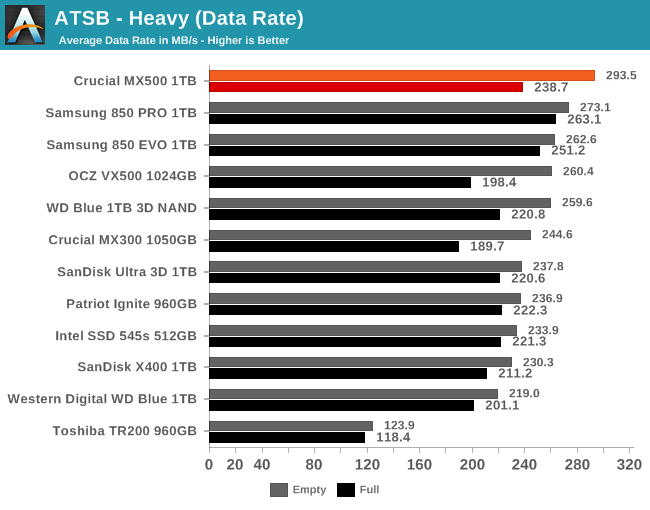
The Crucial MX500 turns in the best average data rate score on the Heavy test that we've seen from a 1TB-class SATA drive. When the test is run on a full drive, the MX500's performance falls below that of the Samsung 850 PRO and 850 EVO.
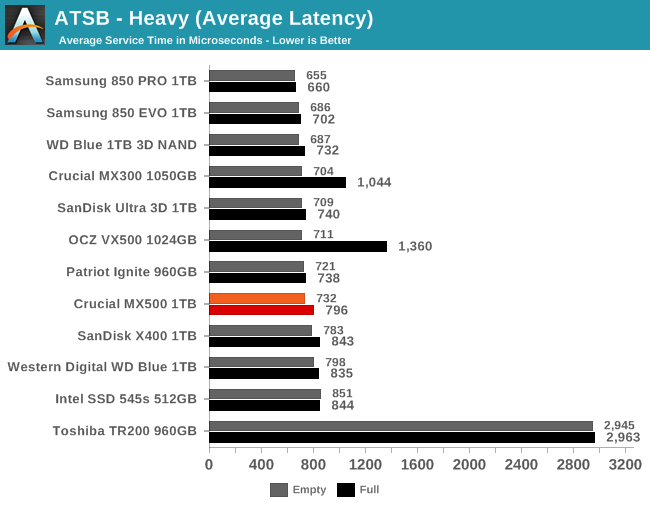
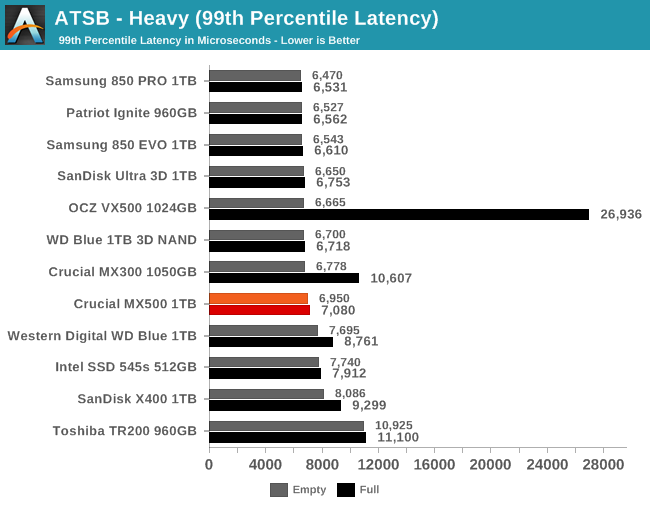
The average and 99th percentile scores of the Crucial MX500 are typical for a good SATA SSD. The MX500 doesn't set any records here, but at least the latency doesn't climb out of control when the test is run on a full drive. This is a notable improvement over the MX300.
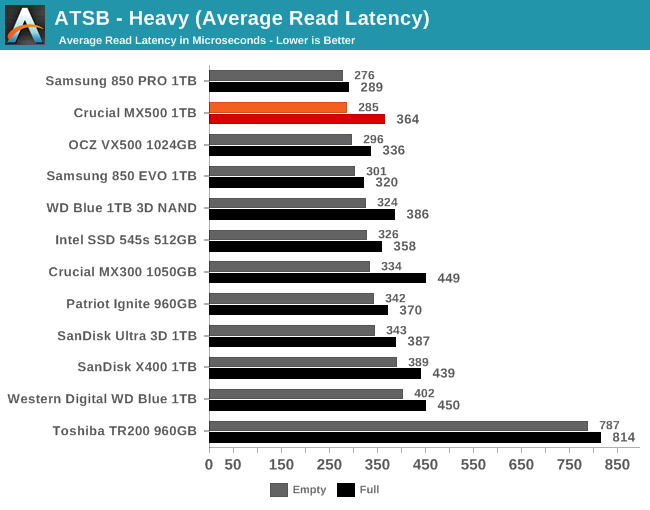
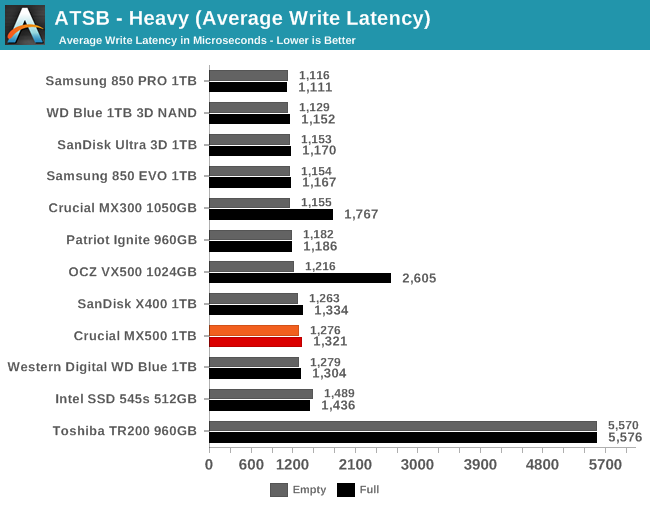
The average read latency of the Crucial MX300 is fast by SATA standards, but it doesn't quite match the Samsung 850 PRO. When the test is run on a full drive, the average read latency suffers and the MX500's score is merely average for a mainstream 1TB drive. The average write latency is slightly below average in both cases, but not to a degree worthy of concern.
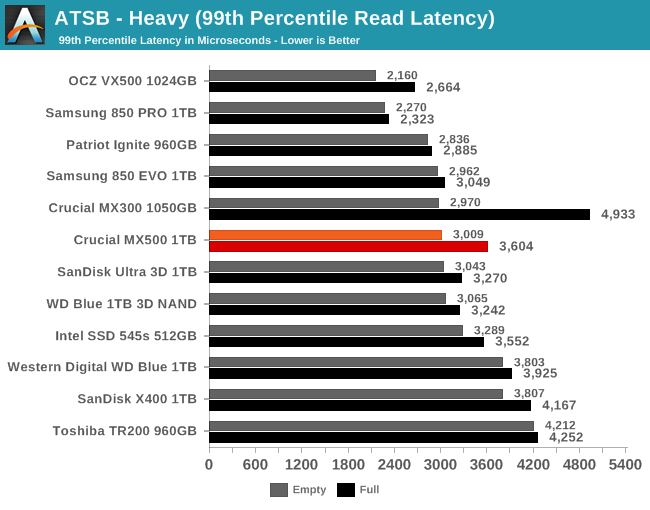
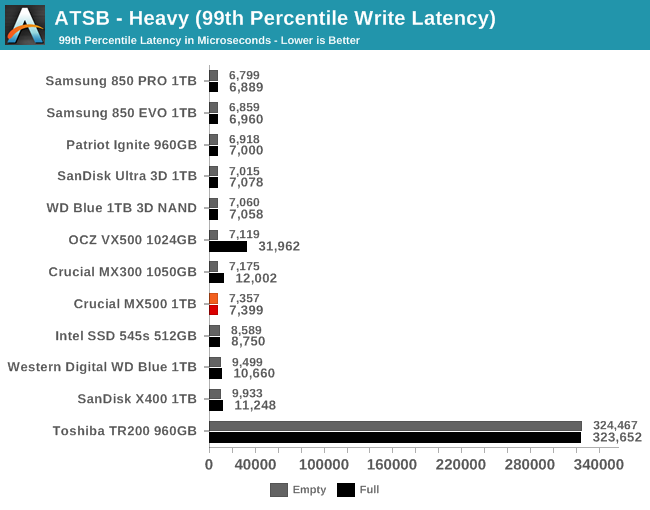
The 99th percentile read latency of the MX500 falls in the middle of the pack, though running the test on a full drive has a bit more of an impact than for most drives. The 99th percentile write latency is reasonably low whether or not the test is run on a full drive.
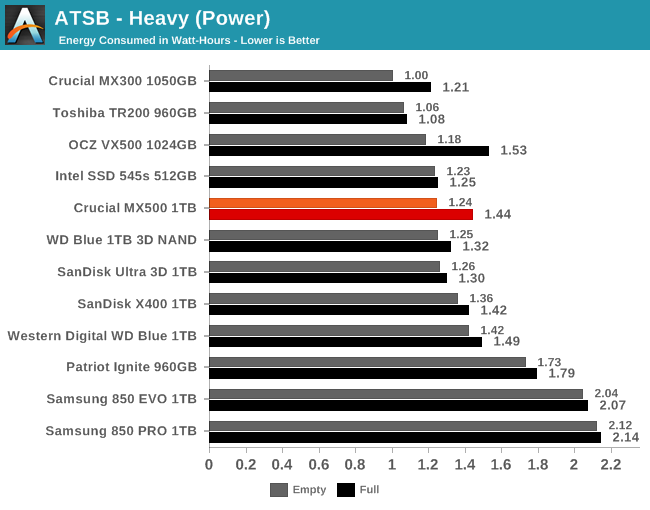
The power consumption of the Crucial MX500 on the Heavy test is significantly higher than the record-setting MX300, but the MX500 certainly doesn't qualify as power-hungry compared to the broader field of competitors. The Samsung 850 PRO and EVO drives require much more power on this test than the MX500.
AnandTech Storage Bench - Light
Our Light storage test has relatively more sequential accesses and lower queue depths than The Destroyer or the Heavy test, and it's by far the shortest test overall. It's based largely on applications that aren't highly dependent on storage performance, so this is a test more of application launch times and file load times. This test can be seen as the sum of all the little delays in daily usage, but with the idle times trimmed to 25ms it takes less than half an hour to run. Details of the Light test can be found here. As with the ATSB Heavy test, this test is run with the drive both freshly erased and empty, and after filling the drive with sequential writes.
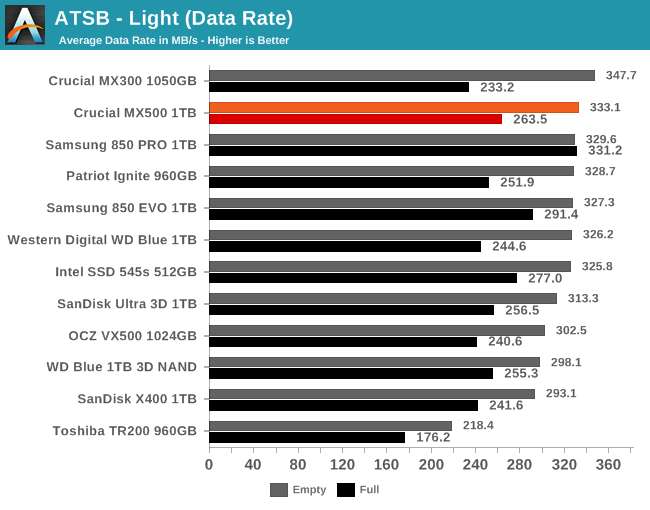
The Crucial MX300 performs very well on the Light test with an average data rate that the MX500 cannot quite match, but the MX500 doesn't lose as much performance when the test is run on a full drive.
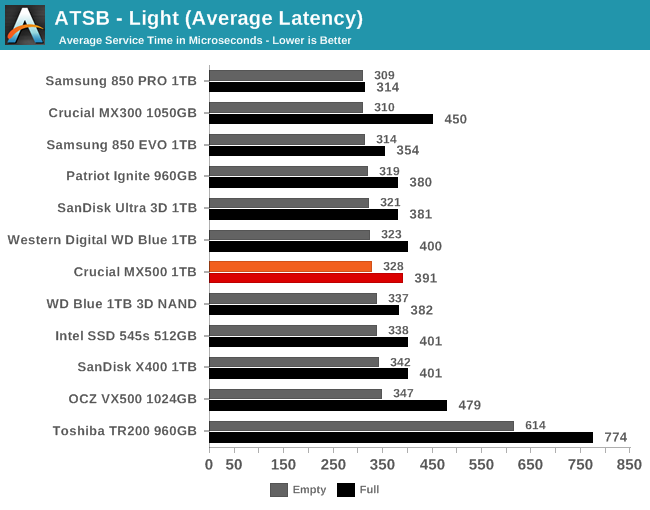
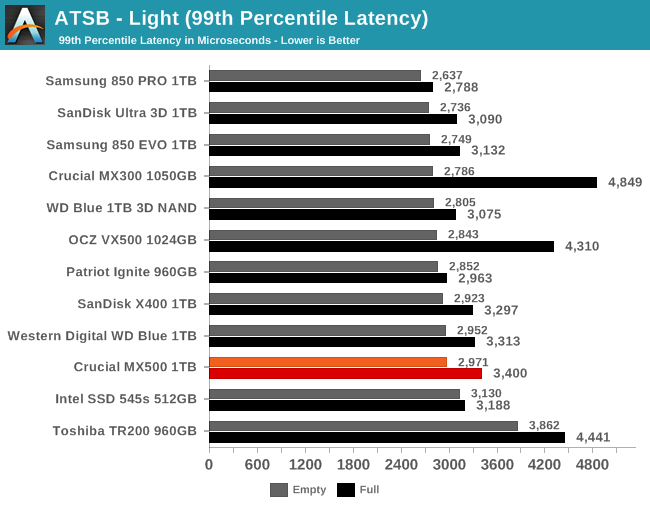
The average and 99th percentile latency scores of the Crucial MX500 are largely unremarkable, though the 99th percentile latency is near the high end of the normal range. The MX500 is a substantial improvement over the MX300 when it comes to full-drive performance.
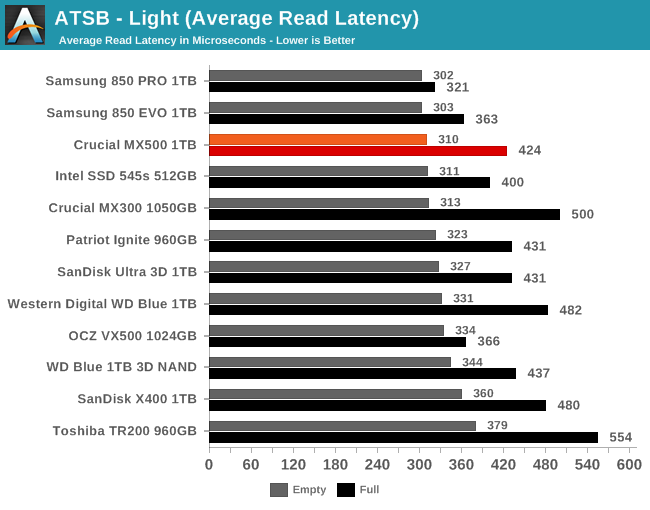
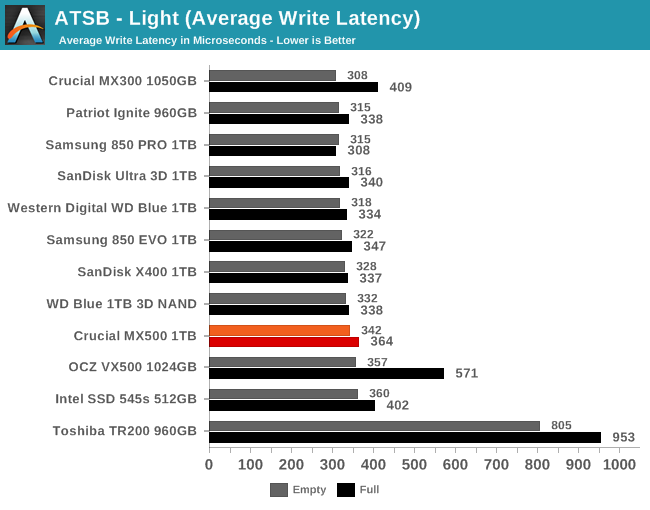
The average read latency of the Crucial MX500 on the Light test is close to the Samsung 850 PRO and EVO when the test is run on an empty drive, but is merely average when the drives are full. The average write latency is a bit below average in both cases, but the full-drive penalty is much reduced compared to the MX300.
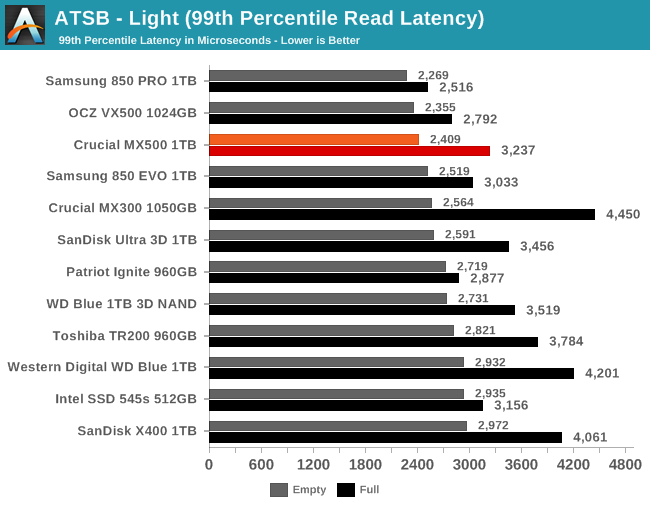
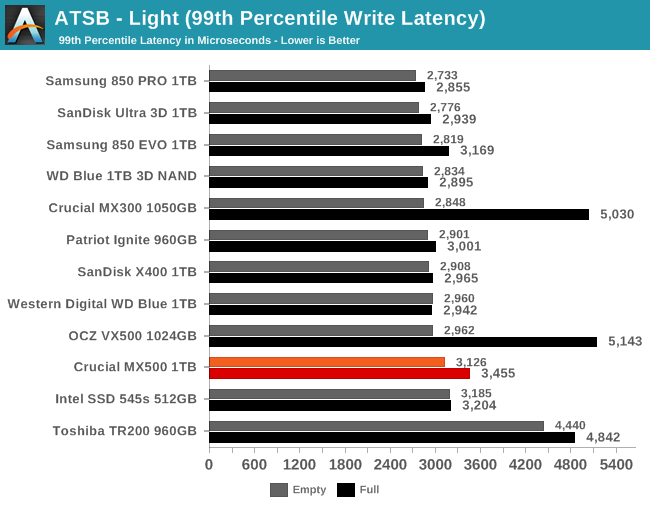
As with the average read and write latency scores, the 99th percentile read and write scores fall within the normal range. The 99th percentile read latency is a bit better than average while the 99th percentile write latency is worse than most drives, but the MX500 isn't an outlier in either direction.
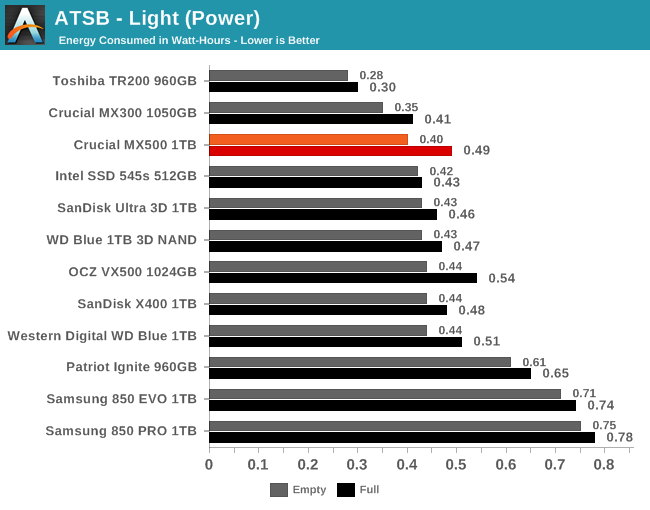
The power consumption of the MX500 ranks a bit better on the Light test than it did on the Heavy test. The Crucial MX300 is still substantially better, and the slow but DRAMless Toshiba TR200 holds on to a comfortable lead. The Samsung 850 PRO and EVO are in last place.
Random Read Performance
Our first test of random read performance uses very short bursts of operations issued one at a time with no queuing. The drives are given enough idle time between bursts to yield an overall duty cycle of 20%, so thermal throttling is impossible. Each burst consists of a total of 32MB of 4kB random reads, from a 16GB span of the disk. The total data read is 1GB.
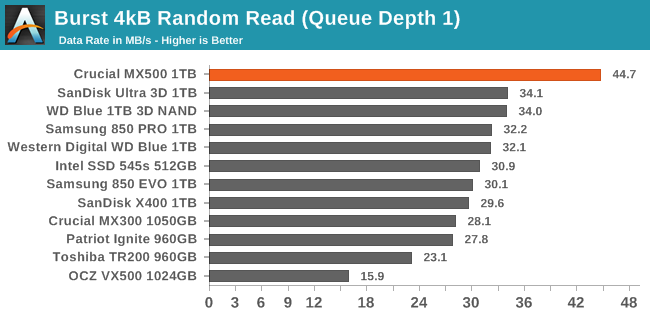
The Crucial MX500 delivers a remarkable QD1 burst random read performance that is much faster than any SATA drive we've tested, and competitive with many NVMe SSDs, even those using MLC NAND. This is a 60% improvement over the MX300.
Our sustained random read performance is similar to the random read test from our 2015 test suite: queue depths from 1 to 32 are tested, and the average performance and power efficiency across QD1, QD2 and QD4 are reported as the primary scores. Each queue depth is tested for one minute or 32GB of data transferred, whichever is shorter. After each queue depth is tested, the drive is given up to one minute to cool off so that the higher queue depths are unlikely to be affected by accumulated heat build-up. The individual read operations are again 4kB, and cover a 64GB span of the drive.
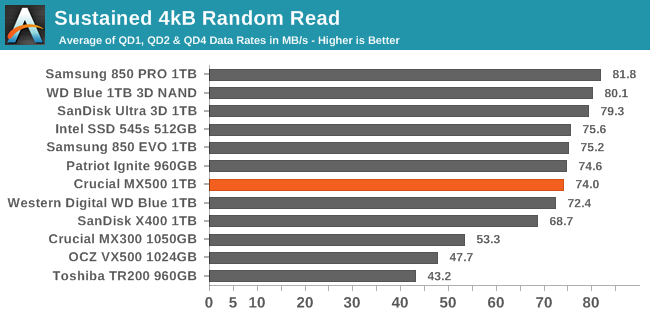
The sustained random read speed of the Crucial MX500 when some higher queue depths are involved is merely average, but still a big improvement over the MX300.
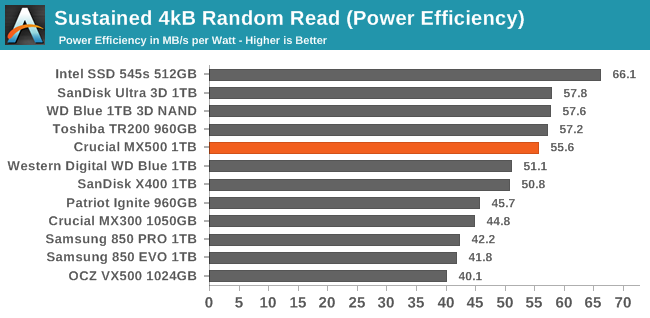
The power efficiency of the Crucial MX500 during random reads is a bit of a disappointment relative to the Intel 545s that uses Intel's similar 64L 3D TLC NAND and a slightly updated Silicon Motion controller. The 545s may have a slight advantage due to our sample being just a 512GB model, but the Crucial MX500's efficiency score is also slightly worse than the drives using Toshiba/SanDisk 64L 3D TLC. Compared to older drives, the efficiency of the MX500 looks great.
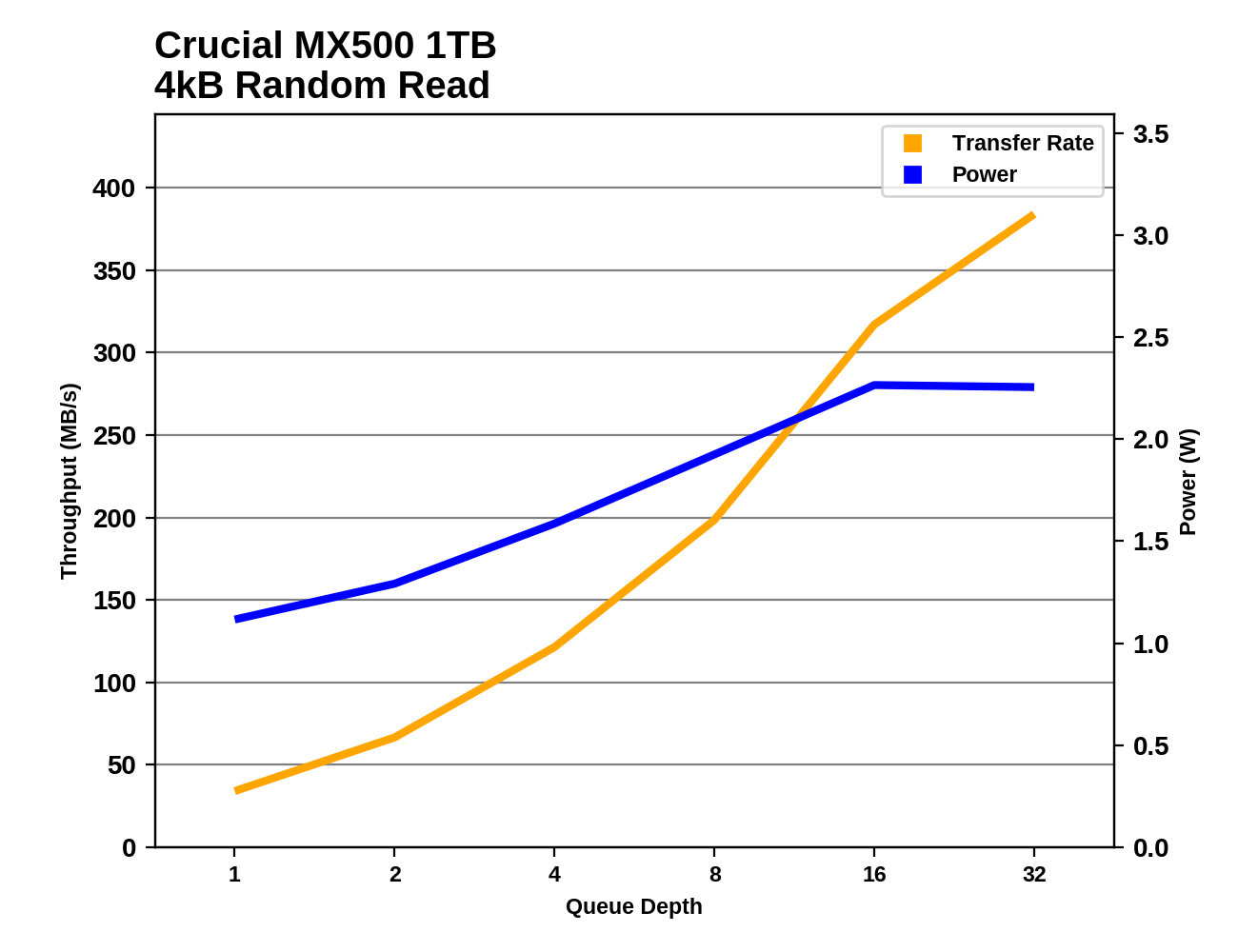 |
|||||||||
The low queue depth performance of the Crucial MX500 is great, and at higher queue depths the Samsung drives and the SanDisk Ultra 3D/WD Blue 3D are the only ones that have a substantial lead over the MX500. At QD32, the MX500 catches up and is tied for first place with the Samsung drives. Through QD8, the Intel 545s offers very similar performance at lower power.
Random Write Performance
Our test of random write burst performance is structured similarly to the random read burst test, but each burst is only 4MB and the total test length is 128MB. The 4kB random write operations are distributed over a 16GB span of the drive, and the operations are issued one at a time with no queuing.
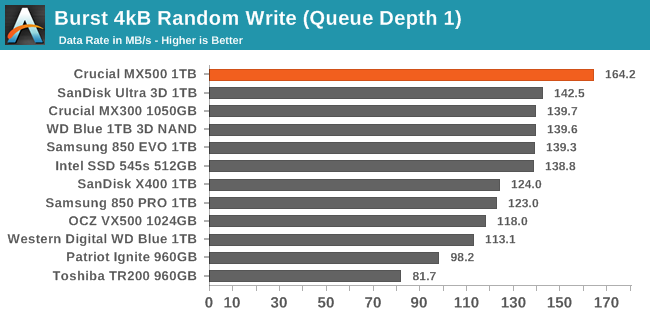
The Crucial MX500 sets another record with its burst QD1 random write performance, but the margin isn't quite as wide as for the random read performance. The other mainstream 3D TLC drives form a clear second tier of performance that is about 15% slower.
As with the sustained random read test, our sustained 4kB random write test runs for up to one minute or 32GB per queue depth, covering a 64GB span of the drive and giving the drive up to 1 minute of idle time between queue depths to allow for write caches to be flushed and for the drive to cool down.
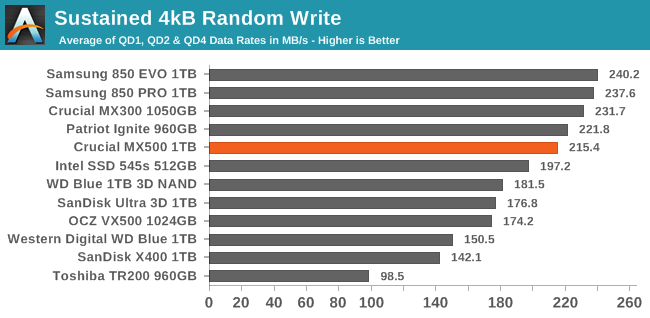
The sustained random write performance of the Crucial MX500 is a bit of a regression compared to the Crucial MX300, but still above average and better than the other 64L 3D TLC drives.
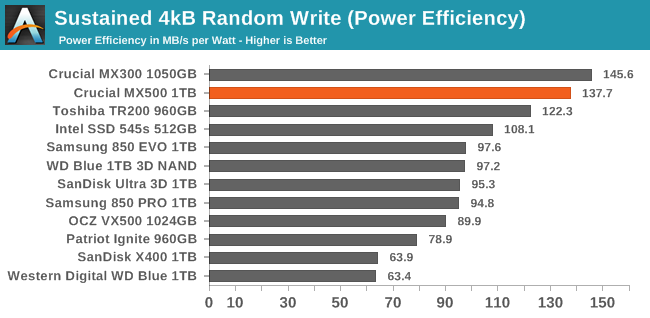
The Crucial MX500's power efficiency during random writes is second only to the MX300, and substantially better than any other mainstream SATA SSD.
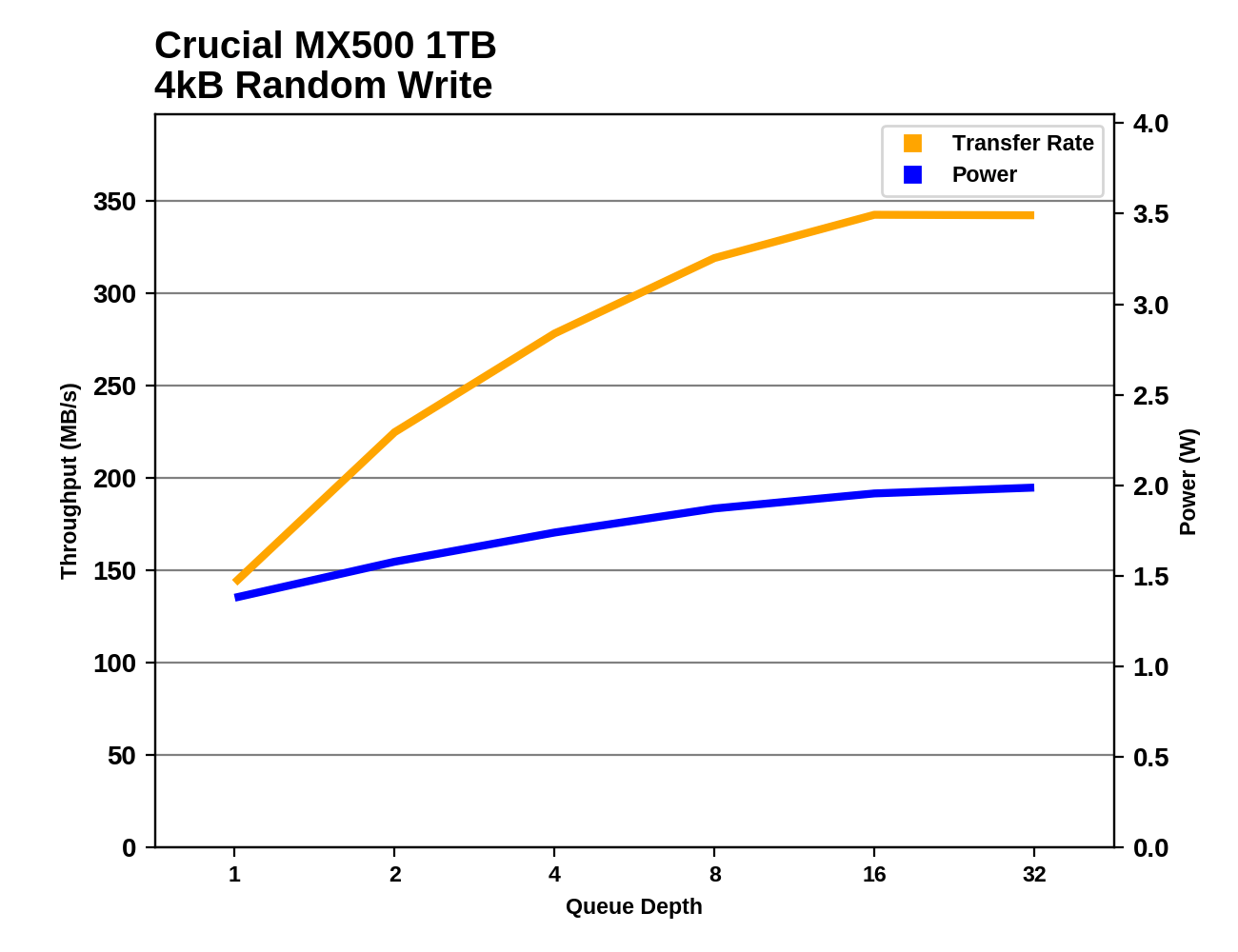 |
|||||||||
As compared to its predecessor, the MX500's random write performance doesn't increase as quickly with higher queue depths, but the MX300 saturates at QD4 leaving the MX500 to catch up and surpass it beyond QD8.
The Samsung 850 PRO and EVO both saturate at about the same level of performance, but they reach that level with much lower queue depths. They also require far more power across the entire range of queue depths.
Sequential Read Performance
Our first test of sequential read performance uses short bursts of 128MB, issued as 128kB operations with no queuing. The test averages performance across eight bursts for a total of 1GB of data transferred from a drive containing 16GB of data. Between each burst the drive is given enough idle time to keep the overall duty cycle at 20%.
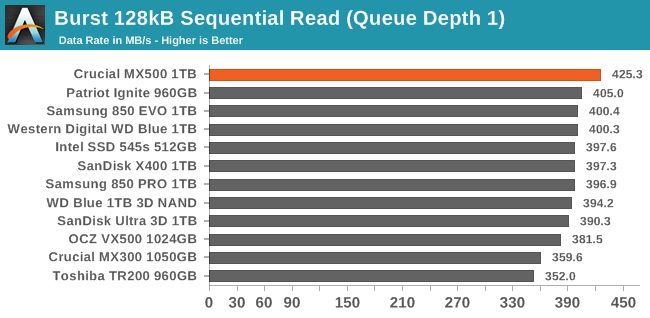
The Crucial MX500 turns in another record-setting burst performance score with its sequential read results, but by the smallest margin yet. It's about 6% faster on this test than most mainstream SATA SSDs.
Our test of sustained sequential reads uses queue depths from 1 to 32, with the performance and power scores computed as the average of QD1, QD2 and QD4. Each queue depth is tested for up to one minute or 32GB transferred, from a drive containing 64GB of data.
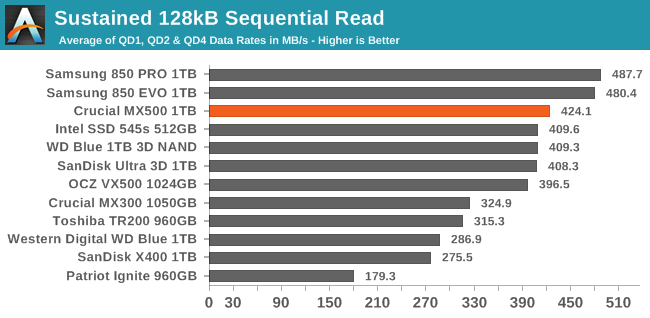
The sustained sequential read performance of the Crucial MX500 puts it in second place, behind the Samsung 850 PRO and 850 EVO. The MX500 does have a slight advantage over the other 64L 3D TLC drives, and improves on the MX300's performance by an impressive 100 MB/s.
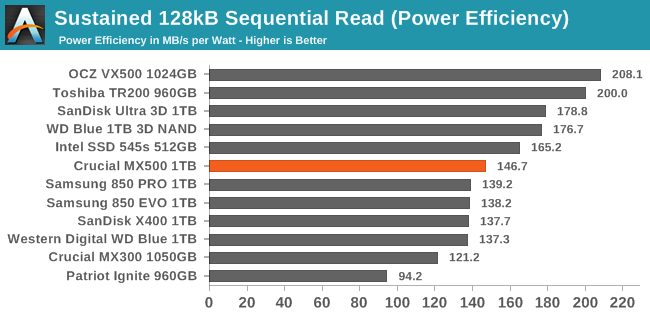
The power efficiency of the Crucial MX500 during sequential reads is mediocre and clearly worse than the other 64L 3D TLC drives, including the Intel 545s. The MX500 is slightly more efficient than the Samsung 850 PRO and EVO, and scores 21% higher than the MX300.
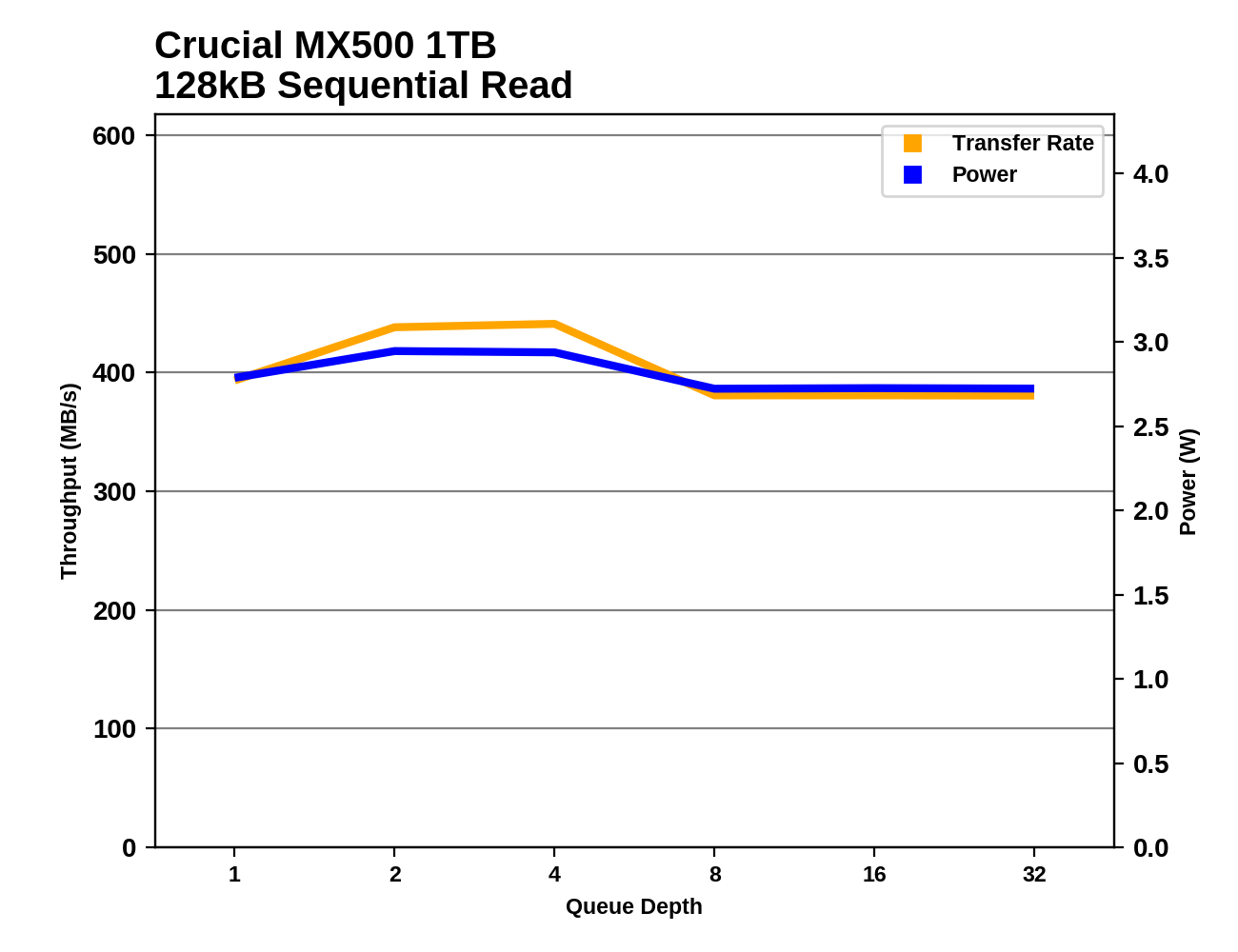 |
|||||||||
The Samsung 850 PRO and EVO are the only drives that continuously saturate the SATA bus from QD2 onwards with no drops in performance. The MX500's performance is reasonably steady but does drop a bit as the test wears on.
Sequential Write Performance
Our test of sequential write burst performance is structured identically to the sequential read burst performance test save for the direction of the data transfer. Each burst writes 128MB as 128kB operations issued at QD1, for a total of 1GB of data written to a drive containing 16GB of data.
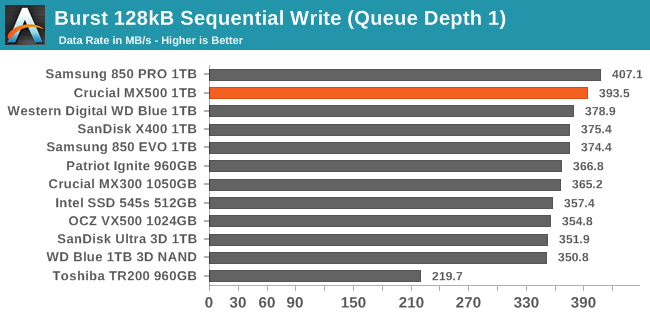
For once, the burst performance of the Crucial MX500 doesn't set a record. Its QD1 sequential write speed is only second-fastest, about 3% slower than the Samsung 850 PRO.
Our test of sustained sequential writes is structured identically to our sustained sequential read test, save for the direction of the data transfers. Queue depths range from 1 to 32 and each queue depth is tested for up to one minute or 32GB, followed by up to one minute of idle time for the drive to cool off and perform garbage collection. The test is confined to a 64GB span of the drive.
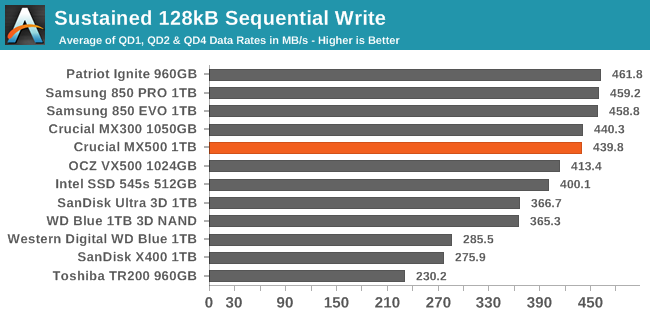
The sustained sequential write speed of the MX500 is the same as the MX300, putting them in the second tier of performance behind the Samsung 850 PRO and EVO and the MLC-based Patriot Ignite.
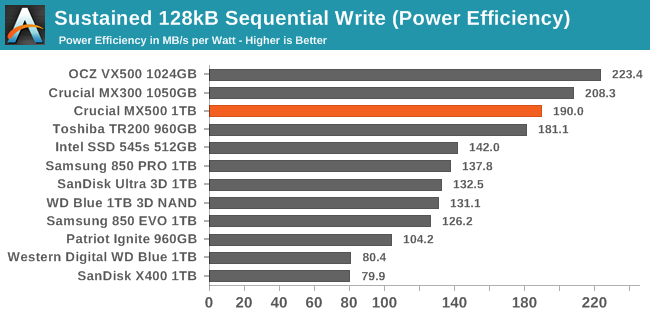
The Crucial MX500 scores great on power efficiency during sequential writes, but not quite as well as the MX300. The OCZ VX500 with its reduced DRAM cache holds on to first place and the Toshiba TR200 (entirely DRAMless) comes in right behind the MX500. The mainstream 3D TLC drives are all much less efficient.
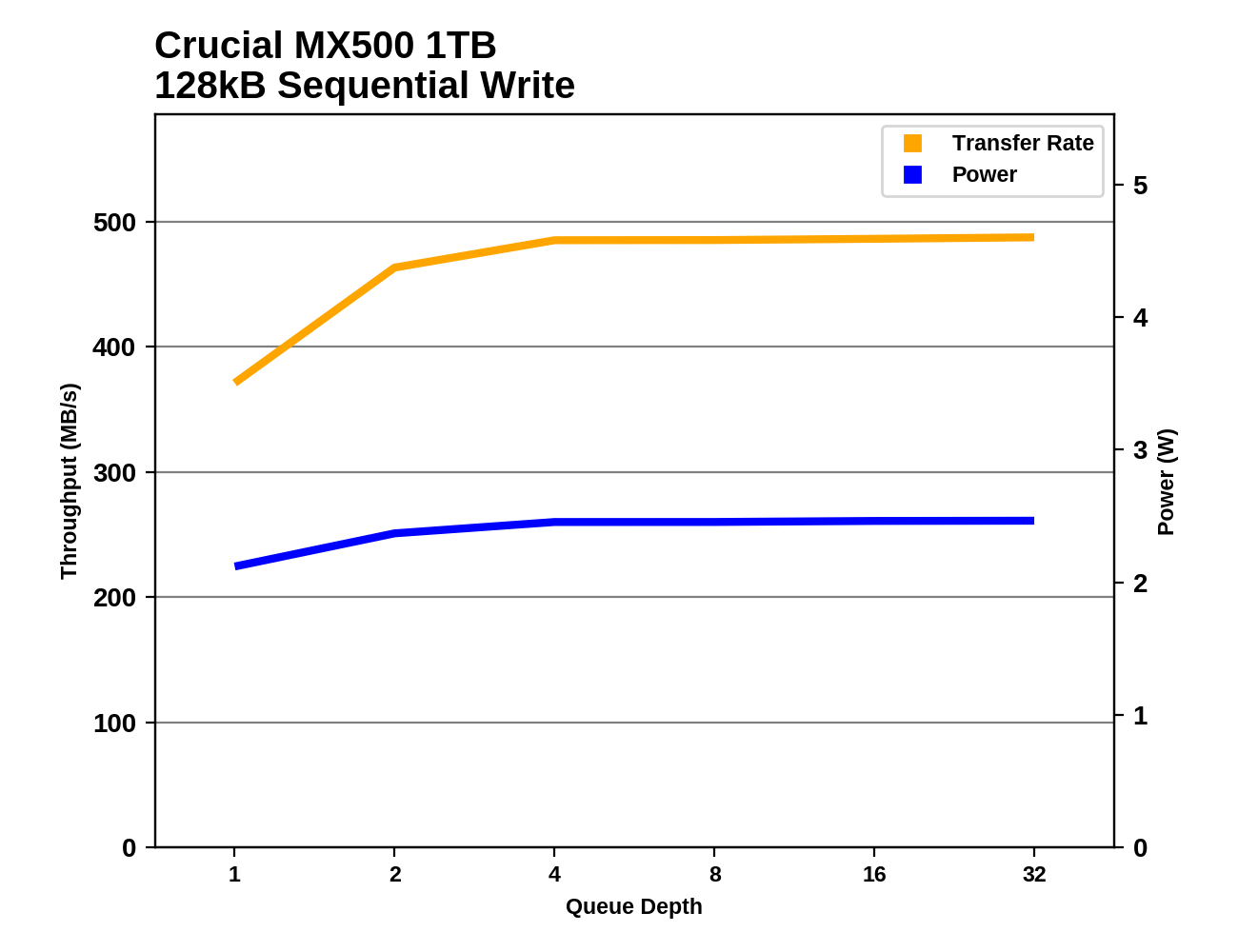 |
|||||||||
Only a few drives offer a higher sustained sequential write speed than the MX500 after reaching saturation. The Samsung drives and the Patriot Ignite are faster at all queue depths and much less pwoer efficient than the MX500, while the OCZ VX500 stumbles at QD2 before saturating with slightly higher throughput and substantially lower power consumption. The MX300 is a bit faster than the MX500 at QD2 but slightly slower at higher queue depths.
Mixed Random Performance
Our test of mixed random reads and writes covers mixes varying from pure reads to pure writes at 10% increments. Each mix is tested for up to 1 minute or 32GB of data transferred. The test is conducted with a queue depth of 4, and is limited to a 64GB span of the drive. In between each mix, the drive is given idle time of up to one minute so that the overall duty cycle is 50%.
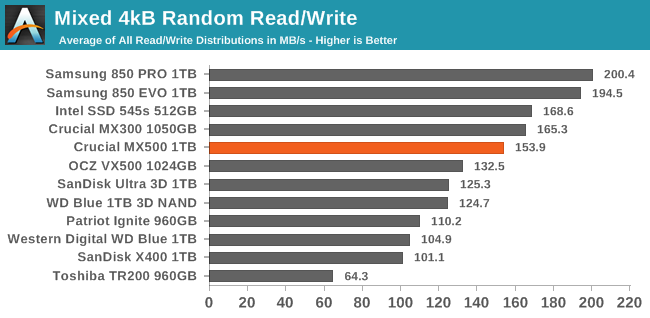
The mixed random I/O performance of the Crucial MX500 is slightly slower than both the MX300 and the Intel 545s, but still above average for mainstream SATA SSDs. The 64L 3D TLC drives from Toshiba and Western Digital/SanDisk are significantly slower, and the Samsung 850 PRO and 850 EVO are still the fastest for this test.
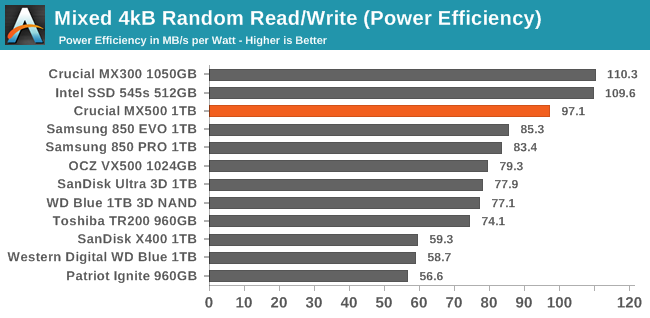
The Crucial MX300 and Intel 545s are tied for first place for power efficiency on this test, with the MX500 coming in third place and well ahead of the other mainstream SATA drives.
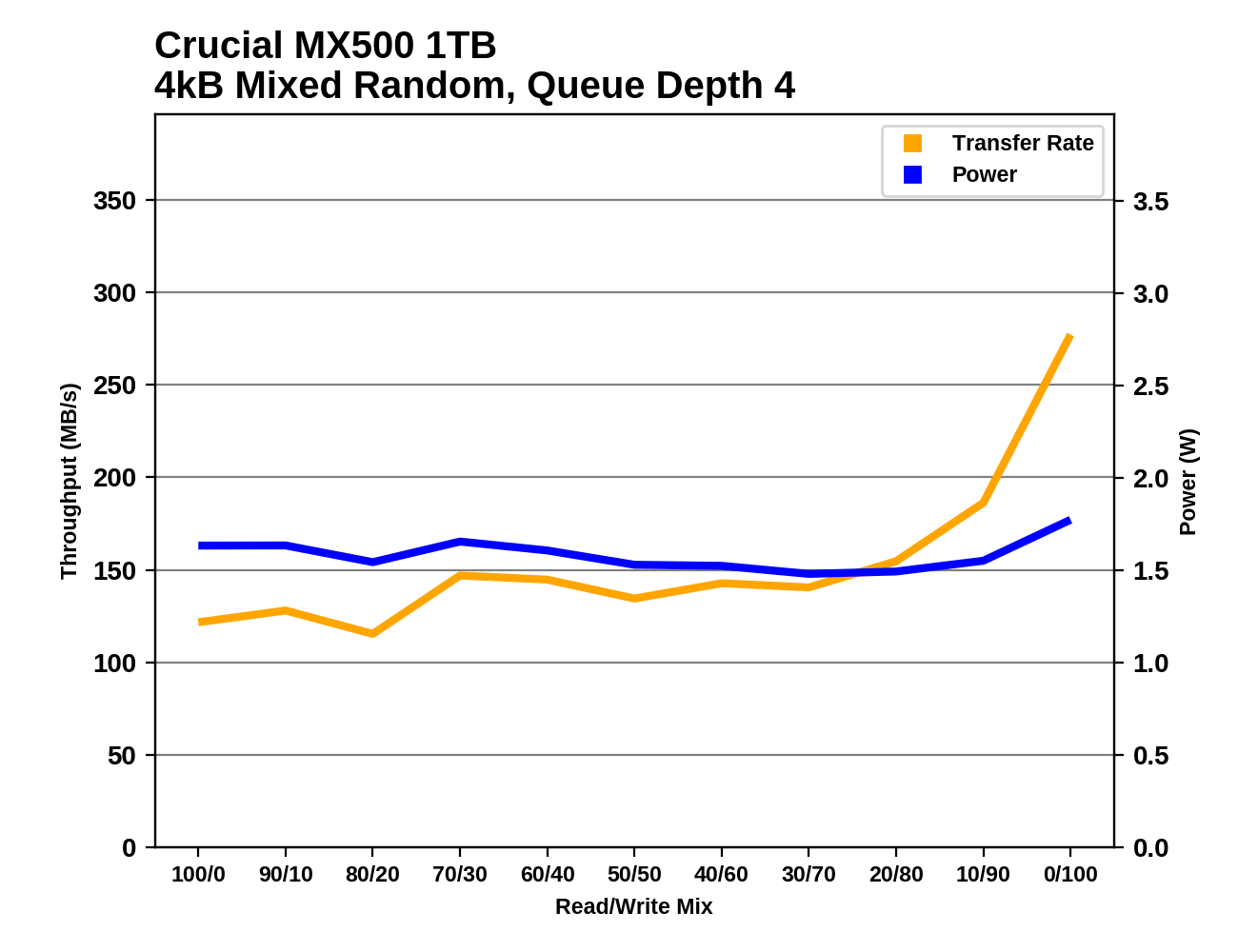 |
|||||||||
The Crucial MX500's performance during this test is a bit unsteady but generally good during the first half when the workload is more read-heavy. The MX500's speed picks up significantly when the workload becomes very write-heavy, but it take too long to start speeding up; other drives like the Samsung 850 PRO and EVO are steadily accelerating with increasing proportion of writes, starting fairly early in the test.
Mixed Sequential Performance
Our test of mixed sequential reads and writes differs from the mixed random I/O test by performing 128kB sequential accesses rather than 4kB accesses at random locations, and the sequential test is conducted at queue depth 1. The range of mixes tested is the same, and the timing and limits on data transfers are also the same as above.
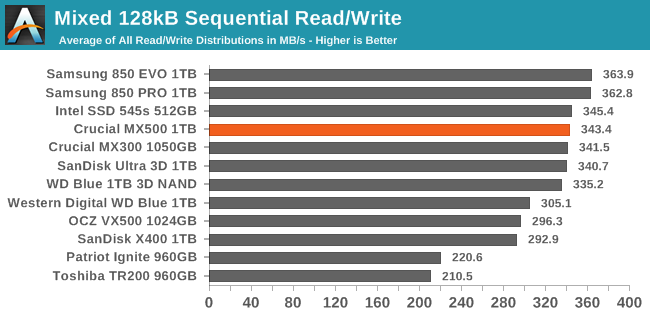
The Samsung 850 PRO and EVO are the fastest SATA drives on the mixed sequential I/O test, and the Crucial MX500 falls into the second tier of drives, along with the other mainstream 64L 3D TLC drives and the MX300.
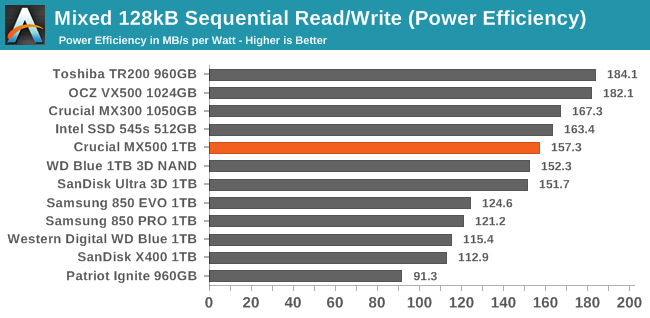
The Toshiba TR200 and OCZ VX500 score highest on power efficiency for the mixed sequential I/O test because they include little or no DRAM. The MX500 scores reasonably well overall but worse than the MX300 and the Intel 545s.
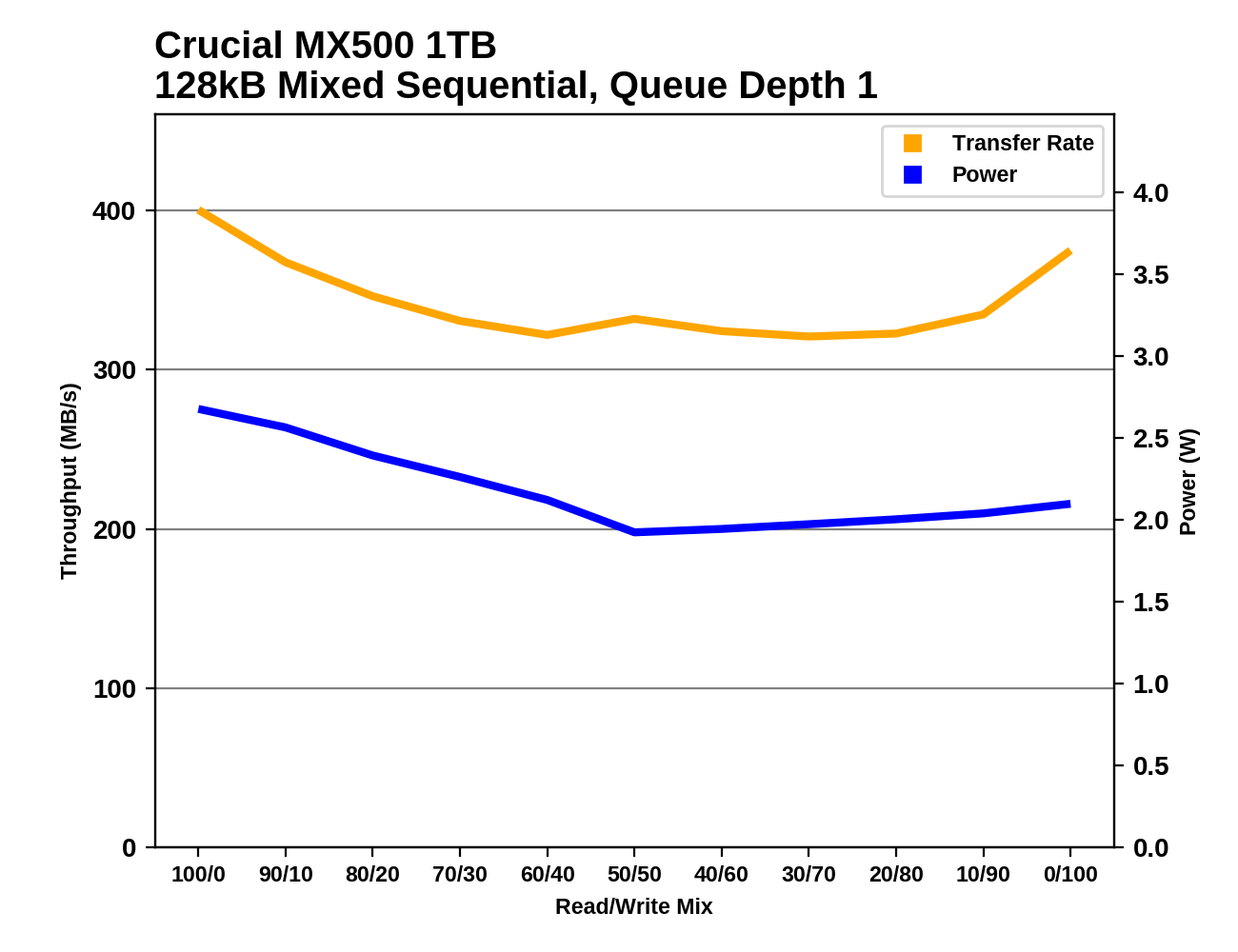 |
|||||||||
The Crucial MX500 performs well in the early, read-heavy phases of the test but performance drops toward the middle and only recovers slightly at the end of the test. The minimum performance level across the entire test is quite high, but the fastest drives spend much less time performing at or near their minimum.
Power Management
Real-world client storage workloads leave SSDs idle most of the time, so the active power measurements presented earlier in this review only account for a small part of what determines a drive's suitability for battery-powered use. Especially under light use, the power efficiency of a SSD is determined mostly be how well it can save power when idle.
SATA SSDs are tested with SATA link power management disabled to measure their active idle power draw, and with it enabled for the deeper idle power consumption score and the idle wake-up latency test. Our testbed, like any ordinary desktop system, cannot trigger the deepest DevSleep idle state.
Idle power management for NVMe SSDs is far more complicated than for SATA SSDs. NVMe SSDs can support several different idle power states, and through the Autonomous Power State Transition (APST) feature the operating system can set a drive's policy for when to drop down to a lower power state. There is typically a tradeoff in that lower-power states take longer to enter and wake up from, so the choice about what power states to use may differ for desktop and notebooks.
We report two idle power measurements. Active idle is representative of a typical desktop, where none of the advanced PCIe link or NVMe power saving features are enabled and the drive is immediately ready to process new commands. The idle power consumption metric is measured with PCIe Active State Power Management L1.2 state enabled and NVMe APST enabled.
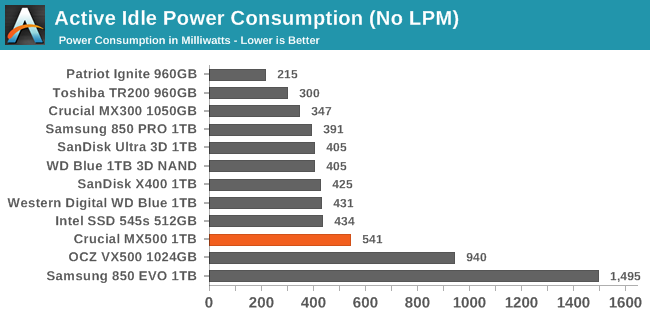
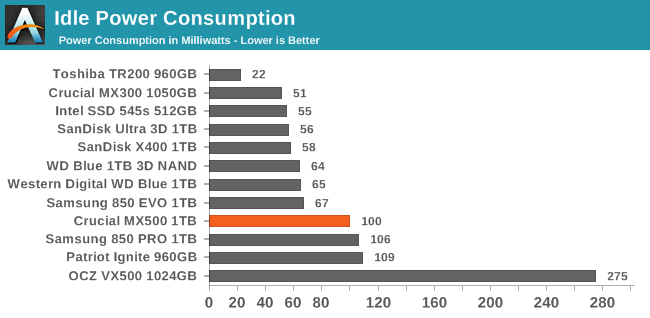
Idle power usage seems to have taken a step backward from the Crucial MX300 to the Crucial MX500. Both the active idle and the slumber power state consumption are higher than most mainstream SATA SSDs, but it isn't one of the extreme outliers that has broken power management.
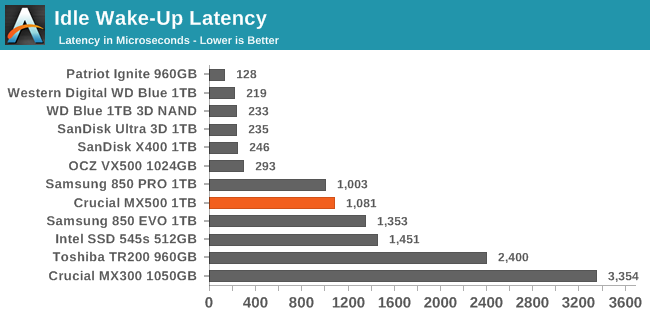
The idle wake-up time for the Crucial MX500 of about 1ms is higher than many mainstream drives, but is a big improvement over the 3.3ms of the Crucial MX300. The Marvell-based drives from Western Digital/SanDisk seem to offer the best combination of low power consumption and quick wake-ups.
Conclusion
Most of the time, it seems like all the interesting new developments in the SSD market are in the NVMe segment, while SATA SSDs are stuck with the same performance limits and decreasing endurance. The Crucial MX500 bucks the trend by setting several surprising performance records while offering competitive mainstream pricing.
The MX500 is a more well-rounded product than its predecessor, the Crucial MX300. The MX300's performance takes a serious hit when it is full or subjected to heavy write loads, but the MX500 retains much more of its performance and does a better job of keeping latency under control. It is still subject to some of the pitfalls of TLC NAND with SLC write caching, but they are mitigated about as well as on any of its competitors.
Several of our synthetic benchmarks returned results for the MX500 that are far above any previous SATA SSD we've tested. The Crucial MX500 is faster at handling short bursts of I/O than any of its competitors, and even outperforms some NVMe drives with MLC NAND. This is exactly the kind of performance that a consumer SSD should focus on: increasing responsiveness, rather than trying to get a high score on a benchmark of throughput with queue depths that consumer workloads never hit.
These optimizations translate into some of the highest average data rates on our ATSB Heavy and Light test that we've seen from a SATA SSD. In favorable conditions (which also happen to be the most common and realistic) of a drive that isn't full and does get TRIM commands from the OS, the MX500 will generally hold its own against any other SATA drive. It isn't at the top of every benchmark—under sustained I/O it isn't any faster than most of its current-generation competition. But for most users, there's no need to pay any extra for the performance of a Samsung drive.
The MX500's power management seems to have taken a step backwards from the impressively efficient MX300. The MX500 is still a reasonable option even for mobile use, but it's a bit disappointing to see that Micron had to sacrifice efficiency on almost every test to improve performance on most of them. The MX500's idle power consumption is also a bit higher than the MX300, but not enough that we worry about something being broken. (It's also possible that our new power measurement equipment is contributing to higher readings; we'll rule out such potential discrepancies over coming weeks by re-testing the back catalog of drives.)
The Crucial MX500 does not stand out as being the top SATA SSD, but it is clearly a top-tier choice. Micron has extended the warranty to 5 years and increased the write endurance rating to match. The performance and power consumption of the Crucial MX500 are suitable for almost every consumer use case. We look forward to the rest of the capacities arriving next year.
| SATA SSD Price Comparison | |||
| 240-275GB | 480-525GB | 960-1050GB | |
| Crucial MX500 | TBA | TBA | $259.99 (26¢/GB) |
| Crucial BX300 | $87.99 (37¢/GB) | $149.99 (31¢/GB) | |
| Crucial MX300 | $89.99 (33¢/GB) | $139.99 (27¢/GB) | $272.00 (26¢/GB) |
| Samsung 850 EVO | $84.99 (34¢/GB) | $139.99 (28¢/GB) | $289.99 (29¢/GB) |
| Samsung 850 PRO | $109.99 (43¢/GB) | $223.42 (44¢/GB) | $399.99 (39¢/GB) |
| SanDisk Ultra 3D | $79.99 (32¢/GB) | $139.99 (28¢/GB) | $279.99 (28¢/GB) |
| WD Blue 3D NAND | $79.99 (32¢/GB) | $139.99 (28¢/GB) | $279.99 (28¢/GB) |
| Toshiba TR200 | $74.99 (31¢/GB) | Out of Stock | Out of Stock |
| Intel 545s | $99.99 (39¢/GB) | $171.99 (34¢/GB) | |
In terms of performance, the SATA drive to beat has long been the Samsung 850 PRO, but its much cheaper sibling the 850 EVO also offers great performance in most use cases and is the most important competitor for mainstream SSDs. The 1TB Samsung 850 EVO is currently selling for $289.99. With the MX500 arriving at $259.99 for the same capacity but with a longer warranty, higher everyday performance and better power efficiency, Samsung needs to change something. The rest of the industry will also have to respond, because the MX500's MSRP is beating the holiday street prices on competitors like the SanDisk Ultra 3D.
The NAND flash shortage is starting to ease as everybody (except SK Hynix) ramps up their 64-layer 3D NAND production. By setting an aggressive introductory price, it is clear that Micron expects SSD prices to be in decline, and they intend for the MX500 to remain an economical choice for the near future. If they can keep the MX500 ahead of the pace of price drops, they have a good chance at recapturing the broad market appeal that once made the MX100 such a clear-cut recommendation. Given how the recent Crucial BX300 is also aggressively positioned, they are probably going to keep up the pressure.

